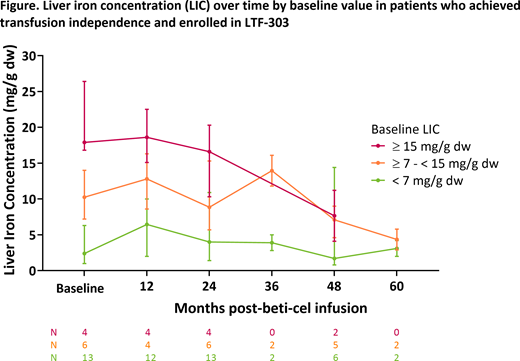
Introduction
The goal of betibeglogene autotemcel (beti-cel; LentiGlobin for β-thalassemia) gene therapy in patients with transfusion-dependent β-thalassemia (TDT) is lifelong, stable production of functional adult hemoglobin (Hb) sufficient for transfusion independence (TI) and reduction in ineffective erythropoiesis. 60 patients with TDT have been treated with beti-cel across 2 completed phase 1/2 studies (HGB-204, HGB-205) and in 2 ongoing phase 3 studies (HGB-207, HGB-212). After 2-yrs of follow-up in these 4 parent studies, patients were invited to enroll in a 13-yr long-term follow-up study, LTF-303 (NCT02633943). Interim results of patients enrolled in LTF-303 with follow-up as long as 6 years are reported.
Methods
Autologous CD34+ cells were transduced with BB305 lentiviral vector and infused into patients following single-agent, pharmacokinetic-adjusted busulfan myeloablation. Transduction in the phase 3 studies used a refined manufacturing process compared to the phase 1/2 studies. LTF-303 assessments include Hb, peripheral blood vector copy number (PB VCN), assessment of erythropoiesis and iron overload, quality of life, adverse events (AEs), replication-competent lentivirus (RCL), and insertion site analysis. Data are analyzed as median (min - max).
Results
As of 3 March 2020, all 32 patients who completed the parent studies (age at enrollment in parent study: 20 [12 - 35] yrs) enrolled in LTF-303 (22 treated in phase 1/2 studies, 10 treated in phase 3 studies). Follow-up post-infusion was 49.1 (23.3 - 71.8) months. PB VCN was detected in all patients at last follow-up (Phase 1/2: 0.4 [0.07 - 4.0] c/dg; Phase 3: 2.0 [0.13 - 3.0] c/dg). Gene therapy-derived Hb, HbAT87Q,in patients treated in the phase 1/2 studies was stable over time: 6.4 (0.5 - 10.1), 6.7 (0.4 - 10.1), 6.6 (0.5 - 10.7), and 7.1 (2.8 - 11.2) g/dL at months 24 (n=22), 36 (n=22), 48 (n=22), and 60 (n=10). Median HbAT87Q at month 24 in patients treated in the phase 3 studies was 9.5 (0.9 - 12.4) g/dL (n=10).
Of the 32 patients enrolled in LTF-303, TI (defined as a weighted average Hb ≥9 g/dL without packed red blood cell transfusions for ≥12 months) was achieved in 14/22 (64%) patients treated in phase 1/2 (12 achieved TI during parent study, 2 during LTF-303) and in 9/10 (90%) patients treated in phase 3 (all achieved TI in parent study). All patients remain TI at last follow-up for 39.4 (19.4 - 69.4) months. Weighted average Hb during TI was 10.4 (9.4 - 13.3) and 12.5 (11.9 - 13.5) g/dL in patients treated in the phase 1/2 and phase 3 studies, respectively. In patients who achieved TI in the phase 3 studies, soluble transferrin receptor decreased from 144.1 (65.9 - 235.3) nmol/L at baseline to 54.1 (24.7 - 67.1) nmol/L at Month 24. Patients who achieved TI in HGB-207 had an improved health state today score from 65 - 96 at baseline to 90 - 100 at month 24 (n=8) on the EQ-5D-3L or EQ-5D-Y instrument.
All patients were on iron chelation before beti-cel infusion, but post-infusion, only 26/32 (81%) patients restarted iron chelation; of these, 11 have since discontinued chelation. Phlebotomy was used for iron removal in 7/32 patients (22%; 3 patients treated in phase 1/2, 4 patients treated in phase 3) including 3 patients who also used iron chelation. Following an initial increase in liver iron concentration (LIC) after infusion, LIC in patients who achieved TI decreased, particularly in patients with an elevated baseline LIC (Figure). The median decrease in LIC from baseline to month 48 in patients who achieved TI was a 38% reduction (85% reduction to 269% increase; n=13).
No drug-product-related AEs were reported >2 years post-infusion. Serious AEs during LTF-303 included gonadotropic insufficiency, ectopic pregnancy, gall bladder wall thickening/polyp, bacteremia with neutropenia. and major depression (all n=1). No deaths, RCL, or insertional oncogenesis were reported. Insertion site analysis as assessed every 6 months until month 60 showed unique insertions accounted for <30% of all insertions indicating polyclonal hematopoiesis.
Summary
These results demonstrate the durability and stability of response after beti-cel gene therapy in patients with TDT. Sustained levels of HbAT87Q and effective iron reduction with phlebotomy and/or iron chelation have resulted in improved hematologic parameters and iron burden. The paucity of gene therapy-related AEs observed beyond 2 years post-infusion study suggests a favorable long-term safety profile.
Kwiatkowski:bluebird bio,Inc.: Consultancy, Research Funding; Terumo Co: Research Funding; Novartis: Research Funding; Sangamo: Research Funding; Celgene: Consultancy; Apopharma: Research Funding; Imara: Consultancy; Agios: Consultancy; BMS: Consultancy. Walters:Editas: Consultancy; AllCells, Inc: Consultancy; Veevo Biomedicine: Consultancy. Locatelli:Bellicum Pharmaceutical: Membership on an entity's Board of Directors or advisory committees; Miltenyi: Speakers Bureau; Medac: Speakers Bureau; Jazz Pharmaceeutical: Speakers Bureau; Novartis: Membership on an entity's Board of Directors or advisory committees, Speakers Bureau; Amgen: Membership on an entity's Board of Directors or advisory committees, Speakers Bureau. Rasko:Novartis: Honoraria; Genea: Other; Imago: Consultancy; Rarecyte: Consultancy, Other; Gene Technology Technical Advisory, OGTR, Australian Government: Other; Advisory Committee on Biologics, Therapeutics Goods Administration, Australian Government: Other; NHMRC Mitochondrial Donation Expert Working Committee: Membership on an entity's Board of Directors or advisory committees; Cure The Future Foundation: Other; FSHD Global Research Foundation; Australian Cancer Research Foundation SAB: Membership on an entity's Board of Directors or advisory committees; bluebird bio, Inc.: Honoraria; Celgene: Honoraria; Pfizer: Honoraria; Cynata: Honoraria; Gilead: Honoraria; Takeda: Honoraria; GSK: Honoraria; CRISPR Therapeutics: Consultancy; Spark: Honoraria. Chen:bluebird bio, Inc.: Current Employment. Colvin:bluebird bio, Inc.: Current Employment, Current equity holder in publicly-traded company. Thompson:Novartis: Consultancy, Honoraria, Research Funding; bluebird bio, Inc.: Consultancy, Research Funding; Biomarin: Research Funding; BMS: Consultancy, Research Funding; Baxalta: Research Funding; CRISPR/Vertex: Research Funding.
Author notes
Asterisk with author names denotes non-ASH members.

This icon denotes a clinically relevant abstract


